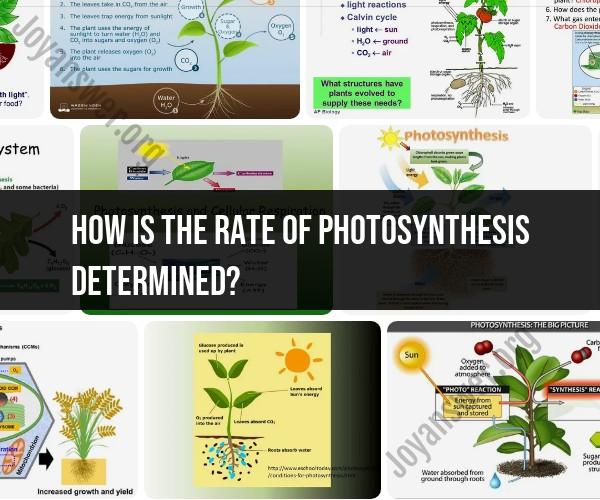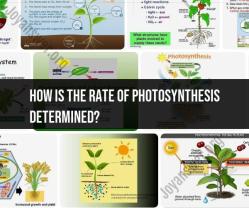How is the rate of photosynthesis determined?
The rate of photosynthesis, the process by which plants and other organisms convert light energy into chemical energy in the form of glucose, is influenced by several key factors. These factors collectively determine the efficiency and speed at which photosynthesis occurs. The primary factors influencing the rate of photosynthesis include:
Light Intensity:
- Light is a critical factor for photosynthesis because it provides the energy needed to convert carbon dioxide and water into glucose and oxygen. As light intensity increases, so does the rate of photosynthesis, up to a certain point where other factors become limiting.
Carbon Dioxide (CO2) Concentration:
- Carbon dioxide is one of the reactants in photosynthesis. An increase in the concentration of CO2 typically leads to an increase in the rate of photosynthesis, assuming that light and other factors are not limiting.
Temperature:
- Photosynthesis is a temperature-sensitive process. Enzymes involved in photosynthesis have optimal temperature ranges for activity. As temperatures rise within this range, the rate of photosynthesis generally increases. However, excessively high temperatures can lead to enzyme denaturation and decreased photosynthetic activity.
Water Availability:
- Water is essential for photosynthesis because it provides the hydrogen ions and electrons needed to convert carbon dioxide into glucose. Inadequate water availability can limit photosynthesis.
Chlorophyll Content:
- Chlorophyll is the pigment responsible for capturing light energy during photosynthesis. Plants with higher chlorophyll content are generally more efficient at photosynthesis.
Nutrient Availability:
- Plants require various nutrients, such as nitrogen, phosphorus, and potassium, as well as trace elements, for optimal photosynthetic function. Nutrient deficiencies can limit photosynthesis.
Leaf Structure and Surface Area:
- The structure and surface area of leaves play a significant role in photosynthesis. Leaves with a larger surface area and well-developed internal structures (such as chloroplasts) can capture more light and carry out photosynthesis more efficiently.
Oxygen Concentration:
- Oxygen is a product of photosynthesis. In some situations, high oxygen concentrations can inhibit photosynthesis. This is more likely to occur in aquatic plants or in conditions where oxygen levels are artificially elevated.
pH Levels:
- The pH level of the plant's internal environment can influence the activity of enzymes involved in photosynthesis. Maintaining an optimal pH is crucial for efficient photosynthesis.
Genetic Factors:
- Different plant species and even individual plants within a species may have genetic variations that affect their photosynthetic capacity.
Environmental Conditions:
- Factors such as air pollution, drought, and high salinity can stress plants and reduce their ability to photosynthesize efficiently.
It's important to note that these factors are interconnected, and changes in one factor can affect others. For example, increased light intensity may lead to higher rates of photosynthesis, but if other factors like CO2 concentration or temperature become limiting, the effect of increased light may plateau.
Understanding the interplay of these factors is essential for optimizing photosynthesis in agricultural practices and for addressing environmental concerns related to plant growth and carbon dioxide absorption.


